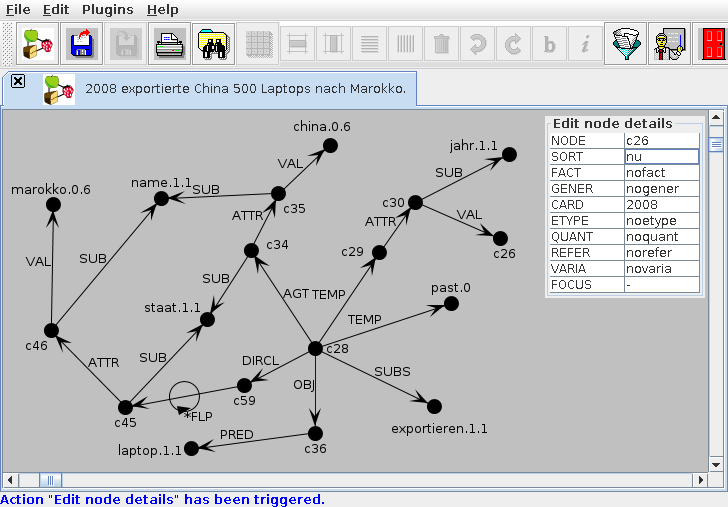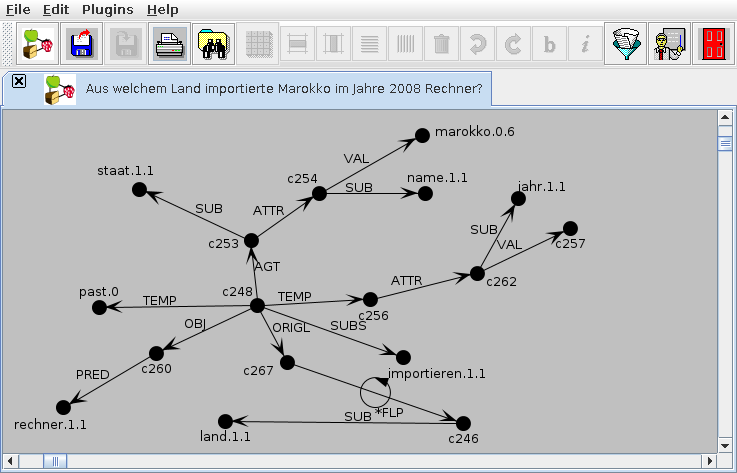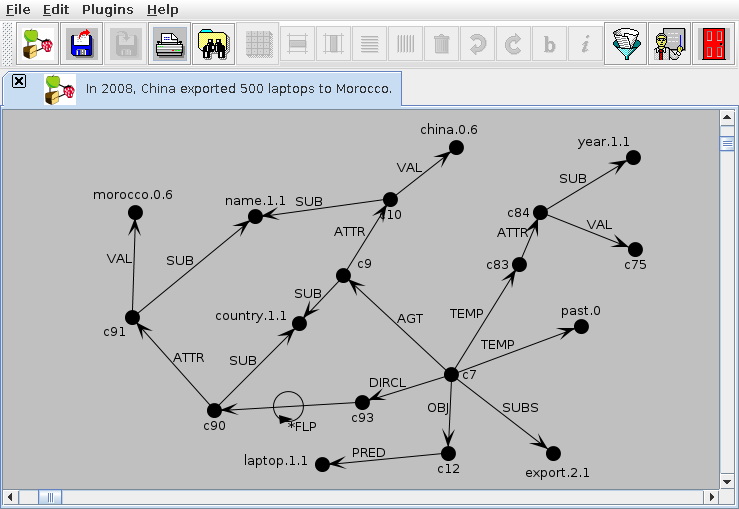
SEMPRIA White Paper:
Introduction to SEMPRIA Search
The Meaning-oriented Search Engine
Dr. Sven Hartrumpf, Prof. Dr. Hermann Helbig
SEMPRIA GmbH
Grafenberger Allee 277–287
40237 Düsseldorf, Germany
https://www.sempria.de/
2012-09-06, last major revision: 2020-10-29
SEMPRIA Search is a search engine of a new type, which for the first time offers meaning-oriented search for German. In contrast to traditional search engines, SEMPRIA Search can resolve word ambiguities and exploit the relations between concepts of the query. In this way, a decisive step is made from simple keyword search to full language understanding. Recall and precision of search are increased by the logical and linguistic foundation of the language technology employed in SEMPRIA Search. To this end, SEMPRIA Search logically relates different concepts from queries and target documents with each other, e.g. (to) import and (to) export or (to) buy and buyer, and understands the linguistic relations between expressions in different document parts.
Traditional search engines are mainly oriented towards keyword search. They cannot resolve word sense ambiguities (i.e., they do not distinguish horse as an animal and horse as a gymnastic equipment), nor can they exploit relations between concepts (i.e., Obama criticizes Merkel and Merkel criticizes Obama are seen as identical—a drastic and dangerous simplification). Hence, keyword search engines flood their users by many irrelevant answers. Due to this shortcoming, several search engines have appeared under the marketing name semantic search engine in recent years. Related to this slogan are basic linguistic functions (like reducing inflected forms to their base forms, so-called lemmatization) and the use of ontologies as background knowledge. An ontology is a conceptual system that is structured by means of certain semantic relations (for example, subsumption, synonymy, and maybe also part-whole relations). This step points into the right direction, but it is insufficient for a significant improvement of search quality.
SEMPRIA1 has been pursuing this deep semantic (or meaning-oriented) approach for many years. SEMPRIA Search hence leverages full, linguistically and logically founded language understanding for texts and for users’ queries aiming at these texts. In contrast to search engines that only achieved first steps of semantic processing (see above), SEMPRIA Search builds on a fully developed theory of meaning representation, the so-called multi-layered extended semantic networks (MultiNet). All language understanding processes and logical search processes in SEMPRIA Search are based on this solid theory. In this way, recall and precision of search results can be increased significantly. For a deeper understanding, a short overview of the scientific foundations is useful; it is presented in the following section.
The development of SEMPRIA Search rests on 20 years of academic research in the areas of automatic knowledge processing, computational linguistics, and computational logics (see https://www.fernuni-hagen.de/helbig/research/). To represent the meaning of natural language expressions (questions, statements, short phrases, or whole texts) on a machine, one needs a suitable knowledge representation system. This system must allow to represent word meanings (collected in a computational lexicon), sentence meanings, and logical relationships between concepts. Only then, one can successfully link the meaning analysis of natural language expressions and the logical answer finding in a search system. With the MultiNet formalism mentioned above and fully described by Helbig (2006), the SEMPRIA GmbH owns such a knowledge representation paradigm. Its comprehensiveness, its logical foundation, the close linkage to components of language technology and logic processes, and the support by corresponding software tools turn MultiNet into a leading approach, even in international comparison. The language processing technology of SEMPRIA has been ranked among the ten most important AI technologies in Germany.2
To illustrate the semantic representation of natural language expressions and to ease the understanding of the following sections, the meaning structures of an example sentence and of a corresponding question are provided in Figure 1 and Figure 2, respectively. Please note that the intelligent language understanding processes in SEMPRIA Search also work properly if a user enters only short search phrases like export to Morocco. SEMPRIA Search can offer search suggestions from one-word queries or two-word queries with unlinked concepts (e.g. morocco export, as preferred by Google users) by extending the query in a meaningful way. Thus, it supports users in better formulating their information needs.



Let us consider the sentence 2008 exportierte China 500 Laptops nach Marokko. (‘In 2008, China exported 500 laptops to Morocco.’), which could be part of a text about import and export business. The meaning of this sentence is represented in Figure 1 as a semantic network, which is automatically computed by the SEMPRIA-NetParser, our syntactico-semantic parser. A semantic network is a graph whose nodes represent concepts and whose edges are relations between concepts. For example, the node c45 stands for a country, which has a name attribute (ATTR relation) with value (VAL) Morocco.3 Similarly, node c34 represents China. The whole sentence describes an export action (node c28), which took place in 2008, represented by two time edges (TEMP). Numbers are typically encoded in the inner structure of nodes, as shown by the popup menu of the SEMPRIA-NetLab tool for node c26 that can be seen in the screenshot. Node c26 represents the year 2008 (layer attribute CARD); the other inner attributes of c26 are irrelevant for this discussion. Finally, the edges AGT, OBJ, and DIRCL (local direction) represent in this order the so-called roles of the export action: the agent, the object (a collection of laptops, attached by the set predicate PRED), and the direction of the export. The relations SUB and SUBS denote the conceptual subordination for objects and actions/events, respectively. They serve to distinguish individual concepts like c45 and c28, which stand for Morocco and a specific export event, from generic concepts like Staat/‘country’ or exportieren/‘export’, respectively.4
Similar to the example sentence that describes an export event (see Figure 1), a question posed by a user with respect to the knowledge base (Aus welchem Land importierte Marokko im Jahre 2008 Rechner?, ‘From which country did Morocco import computers in 2008?’) is automatically analyzed; the resulting MultiNet graph is shown in Figure 2. Some nodes like c256 and c253 have a structure quite similar to certain nodes of the sentence from Figure 1 (in our case, the nodes c29 and c45, respectively). The remaining parts of the semantic network for the question are different: c248 describes an import event (not an export), the agent c253, connected by an AGT relation, is Morocco (not China), the object of the import are computers (not laptops). Finally, the question contains a relation of local origin (ORIGL) (not a local direction, DIRCL). Note that the SEMPRIA-NetParser determined automatically where the user’s center of interest (the question focus) lies; it is represented as node c246. The sought object must be a country. In the meaning representation of the text (which comprises up to now only the semantic network from Figure 1), there is no mention of a country.
The representations are well suited for cross-lingual searching and for translation. This can be seen when comparing Figure 3 (the representation of the corresponding English sentence) to Figure 1 (the representation of the original German sentence). So far, so-called syntactico-semantic parsers for German, English, and Mandarin have been implemented that automatically analyze sentences and represent the results as semantic networks.
To bridge the distance between question and the data provided by texts in a logical way and to analyze the semantics of natural language expressions, additional background knowledge is needed. This knowledge is described in the following section.
The Computational Lexicon SEMPRIA-NetLex Like a person learning a foreign language, a computer needs certain types of background knowledge for natural language understanding. A central part of this knowledge are the descriptions of syntactic and semantic properties of words (coming from computational linguistics).These are collected in a computational lexicon. Besides other, even more subtle difficulties, two main phenomena must be considered: polysemy and homography. A word (e.g. star) can have several meanings or readings; for instance, star.1 – a celestial object, star.2 – a public idol, and others. This phenomenon is called polysemy. In our meaning representation system, we use a numerical index to distinguish the word readings. But there are also words that – although spelled the same – differ both syntactically and semantically. This phenomenon is called homography; in the above example, a homograph to star in the mentioned readings would be the verbal reading (to) star. To distinguish such readings, we use a second numerical index. This explains why all identifiers of semantic network nodes bear two indices (with the exception of artificial concepts of the formalism, having only one index, namely 0): The first distinguishes homographs, the second the readings of a polysemous word. (As demonstrated by our example, both phenomena can occur in connection with one word.)
The automatic distinction of readings, i.e., the reduction of ambiguous words or word forms to unambiguous concepts, is called disambiguation. Automatic disambiguation is a feature of the SEMPRIA search technology and one of the unique selling propositions (USPs) of the SEMPRIA search engine. This disambiguation is not performed by traditional search engines. For illustration purposes, some lexically relevant bits of information for the verbal concept exportieren.1.1/‘export.1.1’ are shown in Figure 4. (As an entry in the computational lexicon, this is called a lexeme.)
![⌊ ⌋
n- sign
|| [ ] ||
|| MORPH BASE ‘exportieren’ ||
|| ⌊MORPH -ORIGIN lex⌋ ||
|| v-syn ||
|| SYN |⌈V-TYPE main |⌉ ||
|| PERF -AUX haben ||
|| ⌊ [ ] ⌋||
|| |SEM sem |||
|| || ENTITY nonment-action ||||
|| ||C -ID ‘exportieren.1.1’ ||||
|| ||DOMAIN general ||||
|| || ⌊ { } ⌋ ||||
|| || | REL AGT | ||||
|| || || OBLIG + || ||||
|| || || ⌊ ⌊np-syn ⌋ ⌋|| ||||
|| || || | | | ||| ||||
|| || || ||SYN ⌈CAT [np ]⌉ |||| ||||
|| || || || AGR CASE nom |||| ||||
|| || || SEL || ⌊ ⌊ sem ⌋⌋|||| ||||
|| || || || | | ⌊ ⌋|||||| ||||
|| || || ||SEMSEL ||SEM || | object ||||||||| ||||
|| || ⌈ ⌈ ⌈ ⌈ ENTITY⌈ LEGPER +⌉⌉⌉⌉⌉ ||||
|| || ⌊ { } POTAG + ⌋ ||||
|| || REL OBJ ||||
|| || || || ||||
|| || || OBLIG +⌊ ⌊ ⌋ ⌋|| ||||
|| || || np-syn || ||||
|| || || ||SYN |⌈CAT np |⌉ |||| ||||
|| SEMSEL || ⟨|| || [CASE acc] |||| ⟩||||
|| ||SELECT || SEL || ⌊AGR ⌊ ⌋⌋|||| ||||
|| || || || sem [ ] |||| ||||
|| || |⌈ |⌈SEMSEL |⌈SEM |⌈ con- object |⌉|⌉|⌉|⌉ ||||
|| || ENTITY MOVABLE + ||||
|| || ⌊ { } ⌋ ||||
|| || REL ORIGL ||||
|| || || OBLIG - || ||||
|| || || ⌊ ⌊ ⌋⌋|| ||||
|| || || | |pp -syn |||| ||||
|| || || SEL ||SYN ||P -POS pre |||||| ||||
|| || ⌈ ⌈ ⌈P -CASE dat ⌉⌉⌉ ||||
|| || { P} -FORM ‘aus’ ∨ ‘von’ ||||
|| || ⌊ REL DIRCL ⌋ ||||
|| || | | ||||
|| || || OBLIG -⌊ ⌊ ⌋ ⌊ ⌋⌋|| ||||
|| || || pp -syn pp-syn || ||||
|| || || || ||P -POS pre|| ||P-POS pre |||||| ||||
|| || |⌈ SEL |⌈SYN |⌈P -CASE acc|⌉∨ |⌈P-CASE dat |⌉|⌉|⌉ ||||
|| || P -FORM ‘in’ P-FORM ‘nach’ ∨ ‘zu’ ||||
|| || ⟨ ⟩ ||||
⌈ ⌈EXAMPLE ‘(DieFirma)(exportiert)(Autos)(ausderHafenstadt)(insNachbarland).’ ⌉⌉
ENTAIL ‘x4 importiert x2 von x1’](SEMPRIA-Whitepaper-Introduction0x.png)
From the lexical entry of exportieren.1.1, one can see5 that this concept (this lexeme) is characterized by the attribute SELECT comprising two obligatory roles (attribute OBLIG with value +) and two optional roles (attribute OBLIG with value -):
For every role, there is an entry specifying how it has to be syntactically embedded in the surface structure of a sentence (attribute SYN), and which entities are allowed to semantically fill this role (attribute SEM). For exportieren.1.1 (export.1.1), the agent AGT has to be expressed by a noun group (noun phrase np) describing an object being able to act (attribute POTAG with value +) or a legal person (attribute LEGPER with value +). The object OBJ must be concrete (attribute value con-object) and movable (attribute MOVABLE with value +). The object has to be expressed by a noun group in the accusative case (attribute value acc). Semantically, the lexeme exportieren.1.1/‘export.1.1’ must denote a non-mental activity (nonment-action), as specified by the attribute SEM. The entailment attribute (ENTAIL) expresses the following relationship 6: from the fact x1 exports an x2 to x4 follows another fact x4 imports x2 from x1. Semantic relationships of exactly this kind allow SEMPRIA Search to establish connections between import and export activities, and many other semantically related concepts. The big advantage of a semantically oriented computational lexicon is that such logical relationships as shown in the example can often be transferred one-to-one into arbitrary other languages. Only the description of the syntactic properties (attribute SYN) and the morphological properties (attribute MORPH) of the words denoting a concept or a lexeme will differ to some degree from one language to another.
The lexical knowledge also comprises so-called idiomatic phrases (like das Handtuch werfen/‘(to) throw in the towel’ for aufgeben/‘(to) give up’) and light verb constructions (like in Verwahrung nehmen/‘(to) take into safekeeping’ for verwahren/‘(to) keep’). The knowledge about such semantic connections enables achievements of SEMPRIA Search that far surpass those of traditional search engines. With the computational lexicon SEMPRIA-NetLex and its tens of thousands of lexical entries, SEMPRIA Search also possesses a unique selling proposition (USP).
In addition to the lexical knowledge stored in the computational lexicon, there is another type of background knowledge applied by SEMPRIA Search. It comprises the following aspects:
Altogether, MultiNet provides around 140 relations (each connected with its logical apparatus). These can be used to represent, to structure, and to store the whole knowledge pertinent to all applications. Every piece of knowledge integrated into the SEMPRIA knowledge base (background knowledge) automatically enhances the power of every SEMPRIA application, especially that of SEMPRIA Search. This means that every user of SEMPRIA products profits from each extension of the knowledge base – be it the computational lexicon or the background knowledge – without any update of its application software.
To support the processes of automatic natural language understanding (NLU), a whole repository of logically and linguistically founded technological means has been developed on the basis of the knowledge representation paradigm MultiNet.7 The following tools are relevant to SEMPRIA Search:
The next section explains how these techniques cooperate during meaning-oriented search.
The SEMPRIA Search engine consists of four main components, each with their respective inner structure (see Figure 5):
The following section shows how the data of the user is integrated into the system.
Typically, the document archive of the user is transferred to SEMPRIA via Internet. The documents can be provided in diverse formats and they are semantically analyzed for inclusion into the search. To this end, a preprocessing is necessary, called indexing, which is normally carried out offline. In contrast to traditional search engines, labor-intensive and complex processes are initiated by SEMPRIA Search during this indexing, aiming at a possibly far-reaching language understanding, as explained in the foregoing sections. The documents are translated into semantic networks according to the MultiNet formalism and connected to the knowledge already gathered (data integration into the document base). During the retrieval phase, the search engine can finally work with these coherent semantic networks; that means it can logically compare and semantically deduce. On the technical level, customer-specific information and general background knowledge are strictly separated during the construction of the document archive, thus, always guaranteeing the protection of proprietary or confidential data.
Currently, SEMPRIA Search is able to integrate the following formats (this list can easily be extended according to user requirements):
It goes without saying that a comprehensive and clean integration of metadata is strictly observed by SEMPRIA Search. Only in a few cases, manual steps are required during this process. These include the provision of additional information connected to certain formats (such as tables) or the correction of errors resulting from the application of text recognition systems (OCR). Indexing and updating of documents are carried out during times agreed upon and after predefined time intervals. They are initiated by transferring a simple list of URLs, using a standard protocol (like HTTP, HTTPS, FTP, or SFTP) for the transfer actions.
Summarizing, we can state that the application of SEMPRIA Search warrants a considerable advantage to the user compared with traditional search engines. In this context, only the most important aspects shall be emphasized:
Helbig, Hermann (2006). Knowledge Representation and the Semantics of Natural Language. Berlin: Springer.
1SEMPRIA is a registered trademark.
2 https://ki50.de/die-zehn-bedeutenden-technologien-der-deutschen-ki-geschichte/
3The indices of the concept names can be ignored; they are related to word ambiguities (for this reason, one cannot use words as node identifiers, see Section 3).
4The careful reader might have noticed the concept staat.1.1 (superordinated to nodes c45 and c34), which is not contained in the sentence. This concept was found during the analysis in the background knowledge (see Section 3) and added to the semantic network.
5The morphological properties (attribute MORPH) and the syntactic properties (attribute SYN) of the verb exportieren itself, denoting the concept or lexeme with the name exportieren.1.1 (see C-ID), will be ignored in this short explanation.
6x1 to x4, by convention, stand in this order for the roles (arguments) in the lexeme specification (see Figure 4), in this case AGT, OBJ, ORIGL, and DIRCL, respectively.
7Figures 1, 2, and 4 have been produced by using these tools.